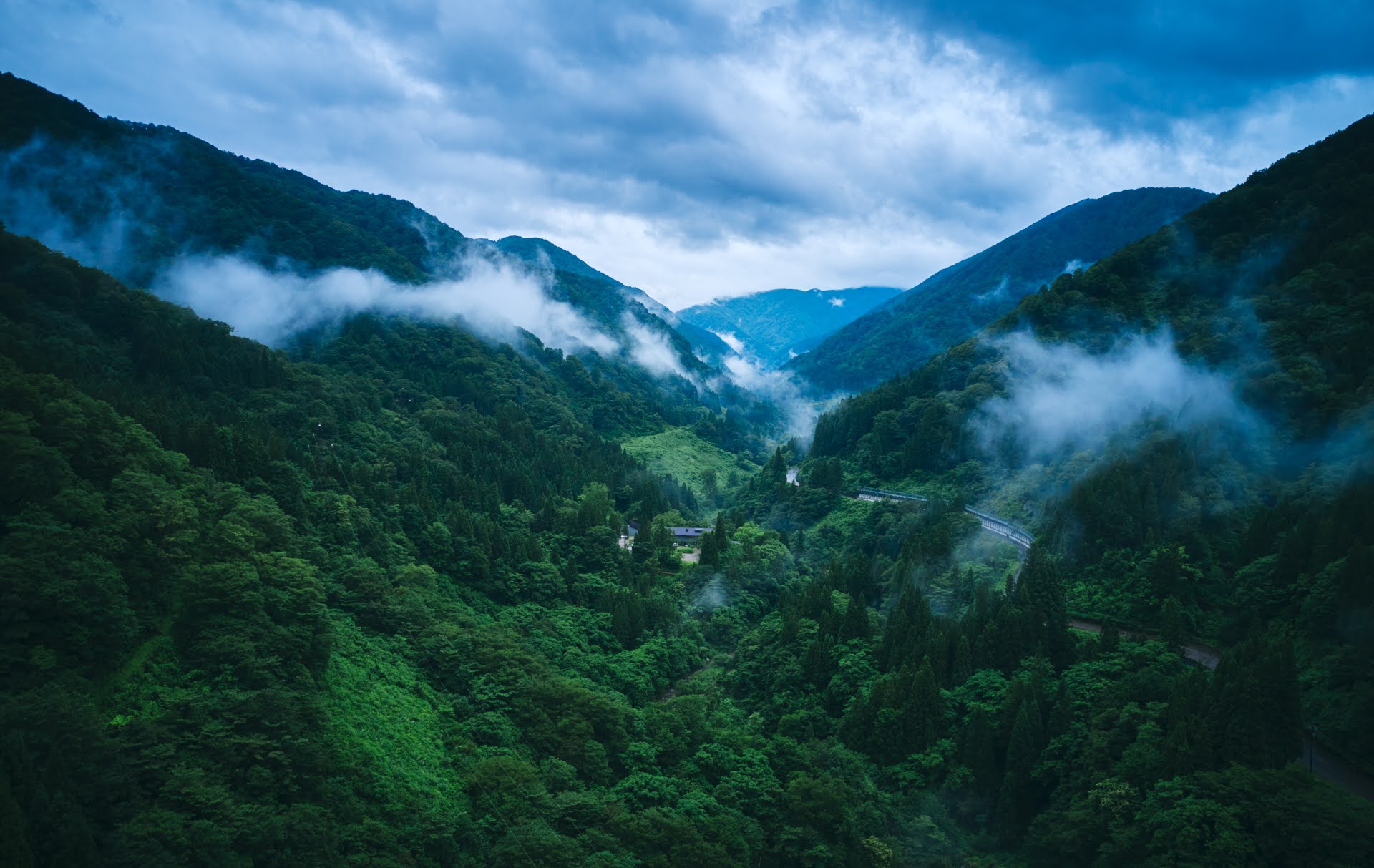Toga Village of Nanto City, is located in the southwestern part of Toyama Prefecture. It is a small and remote town with a population of about 500 people.
Located near Gokayama, which is known for its Gassho-zukuri architecture (wooden houses with a distinct steep rafter roof), it is by no means in a convenient location. In order to reach this area one must drive through mountain paths, forests, and along rivers, up and down winding narrow roads.
After you make it through the sometimes frightening cliff-side roads, you will find a stunning and breathtaking view of the mountainscape.
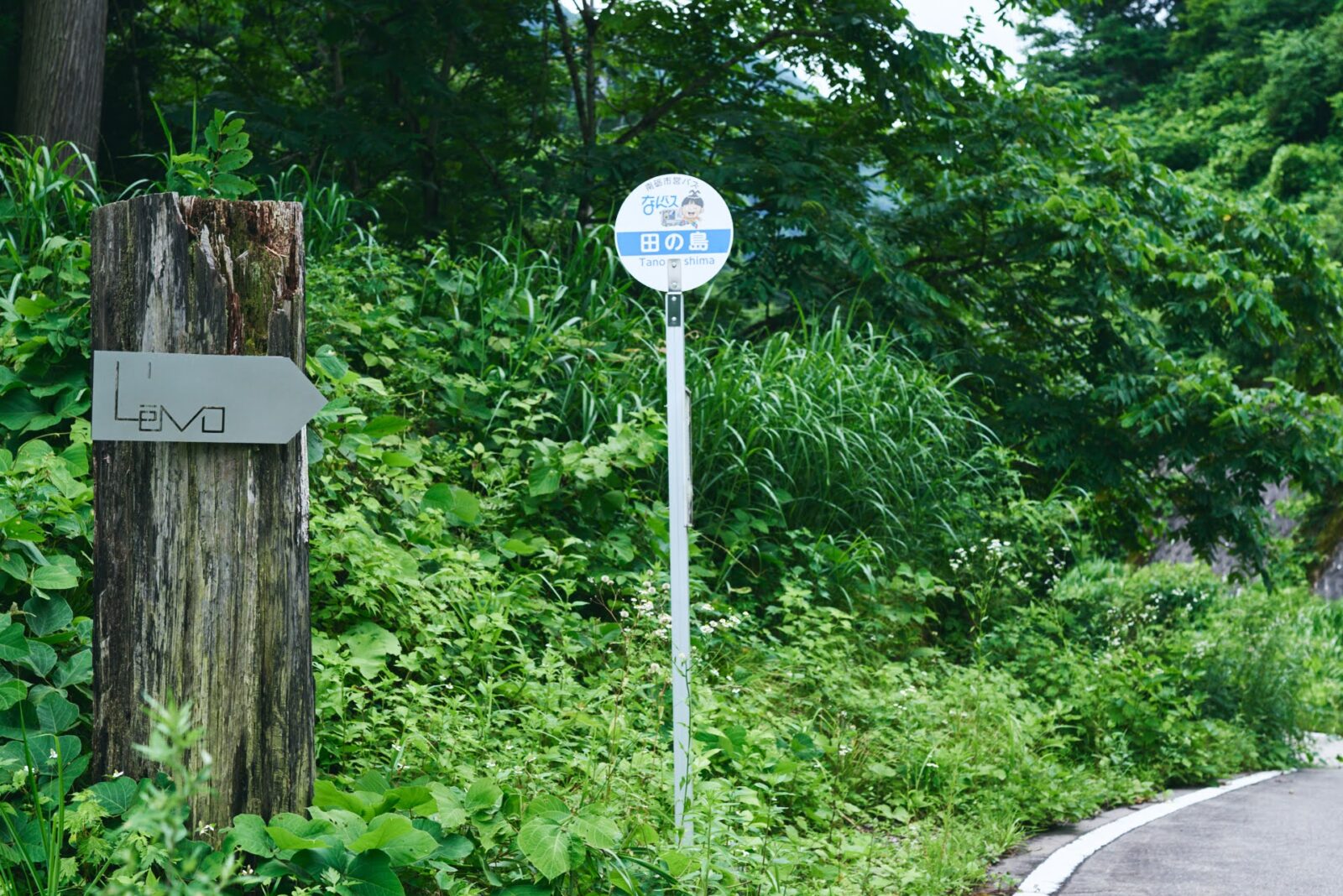
It feels like you are on an exciting adventure as you head deeper and deeper into the mountains, and just when you feel like you may be lost the auberge appears in the distance, tucked away in the quiet mountains surrounded by greenery.
L’évo is a restaurant that any food lover dreams of experiencing, even if it means traveling all this way. Chefs and food lovers from around the world gather here to enjoy the cuisine to their heart’s content.
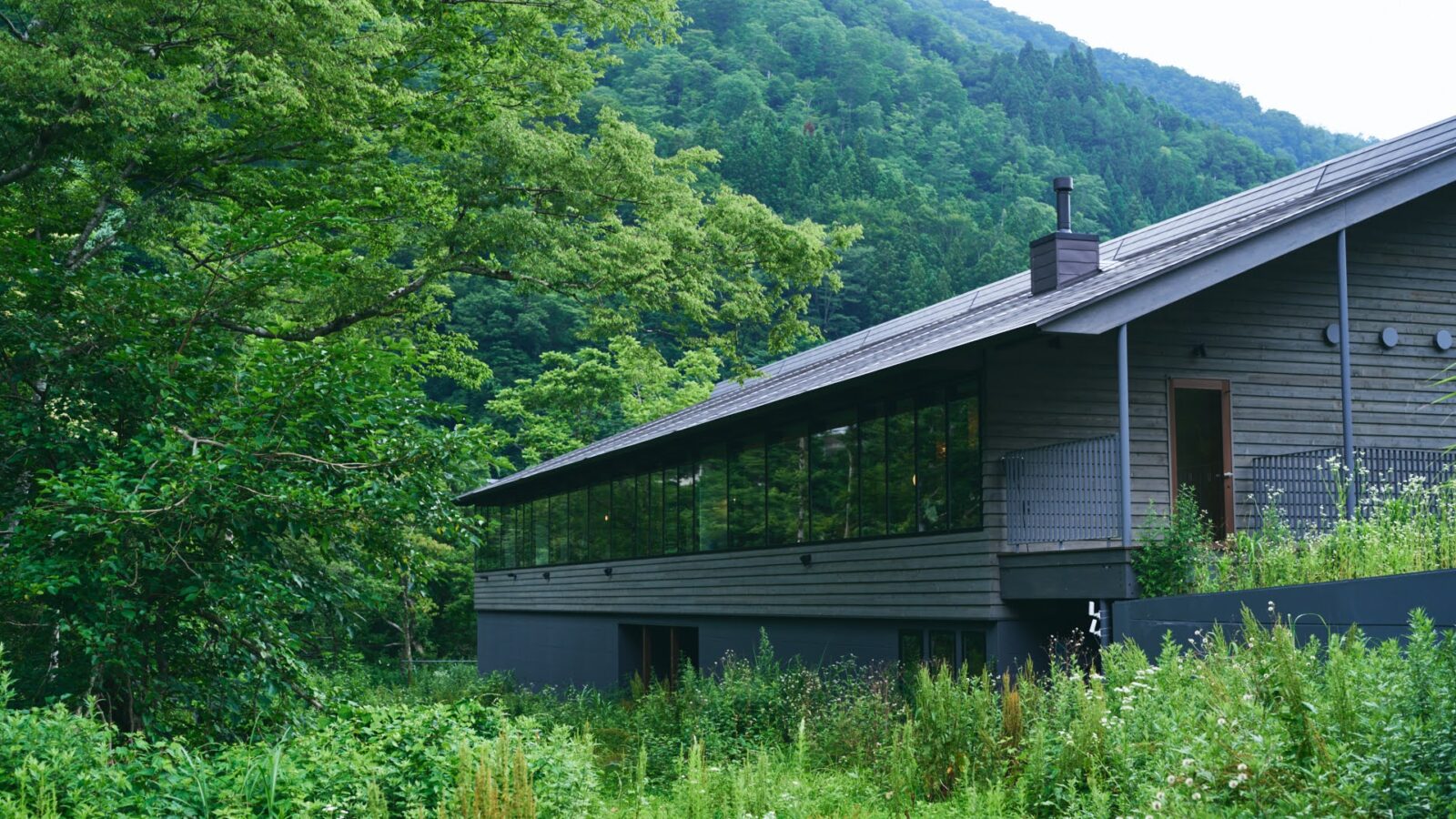
This place offers the ultimate local gastronomy experience and all that Toyama has to offer.
We came to experience L’évo’s cuisine, which uses an abundance of local ingredients, along with their special non-alcoholic drink pairings.
In 2003, L’évo’s owner and chef Eiji Taniguchi received the Tsuji Shizuo Award’s Specialized Technique Award for cultivating a new world in cuisine.
Taniguchi says that “Food becomes delicious simply on its own.” We spoke to Taniguchi about his approach to cooking and the dining experience created in Toyama’s rich natural environment.
L’évo’s artistic course menu enjoyed with non-alcoholic drink pairings
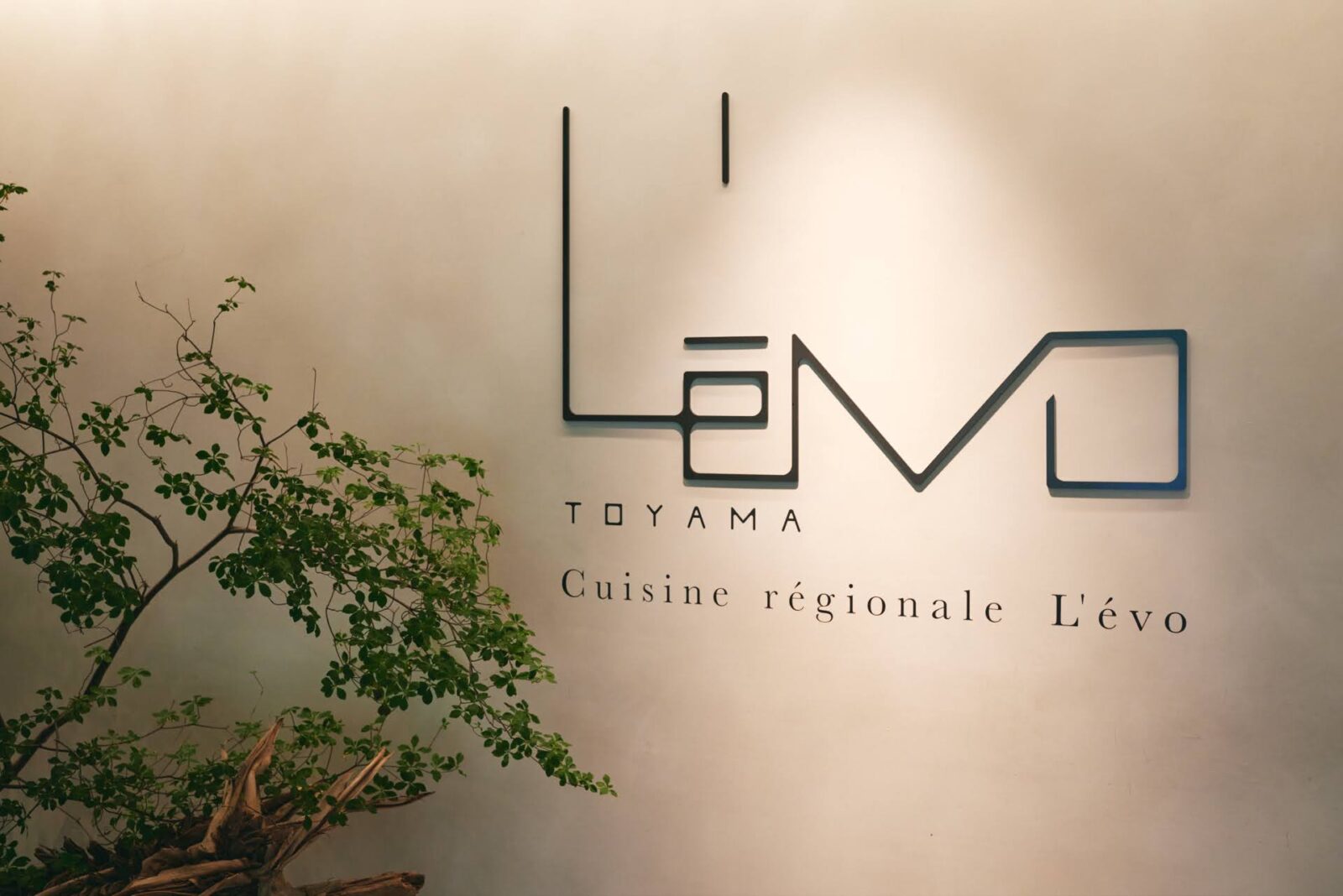
Entering the restaurant’s building almost feels like entering a museum.
The walls are decorated with art pieces of traditional Toyama Inami Woodcarvings and the room is lit up with lamps made from black sea bream fish skin leather.
The restaurant’s beautiful wood grain furniture is designed by woodworker Shimoo Design. A drawer on the table opens up to reveal jewel-like sake cups made by glass artist Taizo Yasuda. All of the artwork in the restaurant is made in Toyama.
Even before the course meal begins, we are captivated by this place.

The first thing we are served is mountain spring water and then the syrup of a Itaya maple in a glass cup called “forest dewdrop” made by Yasuda. The Itaya maple is a common tree in the area, and the syrup is collected by woodcutters only once a year, in spring as the snow melts in the mountains.
Forest Dewdrop
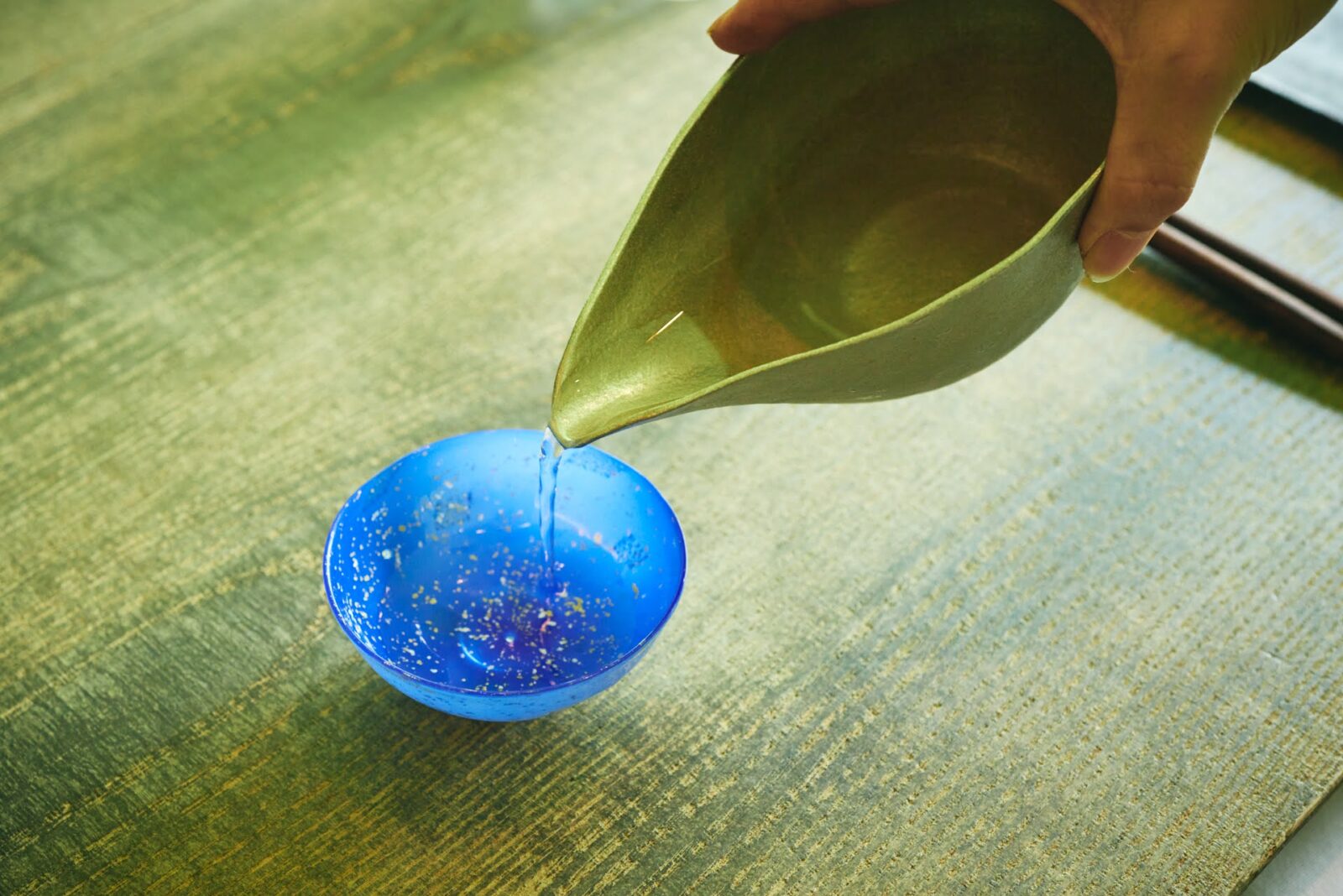
As the gentle yet rich and slightly sweet drink slowly seeps through your body, you feel a connection to the earth of Toyama.
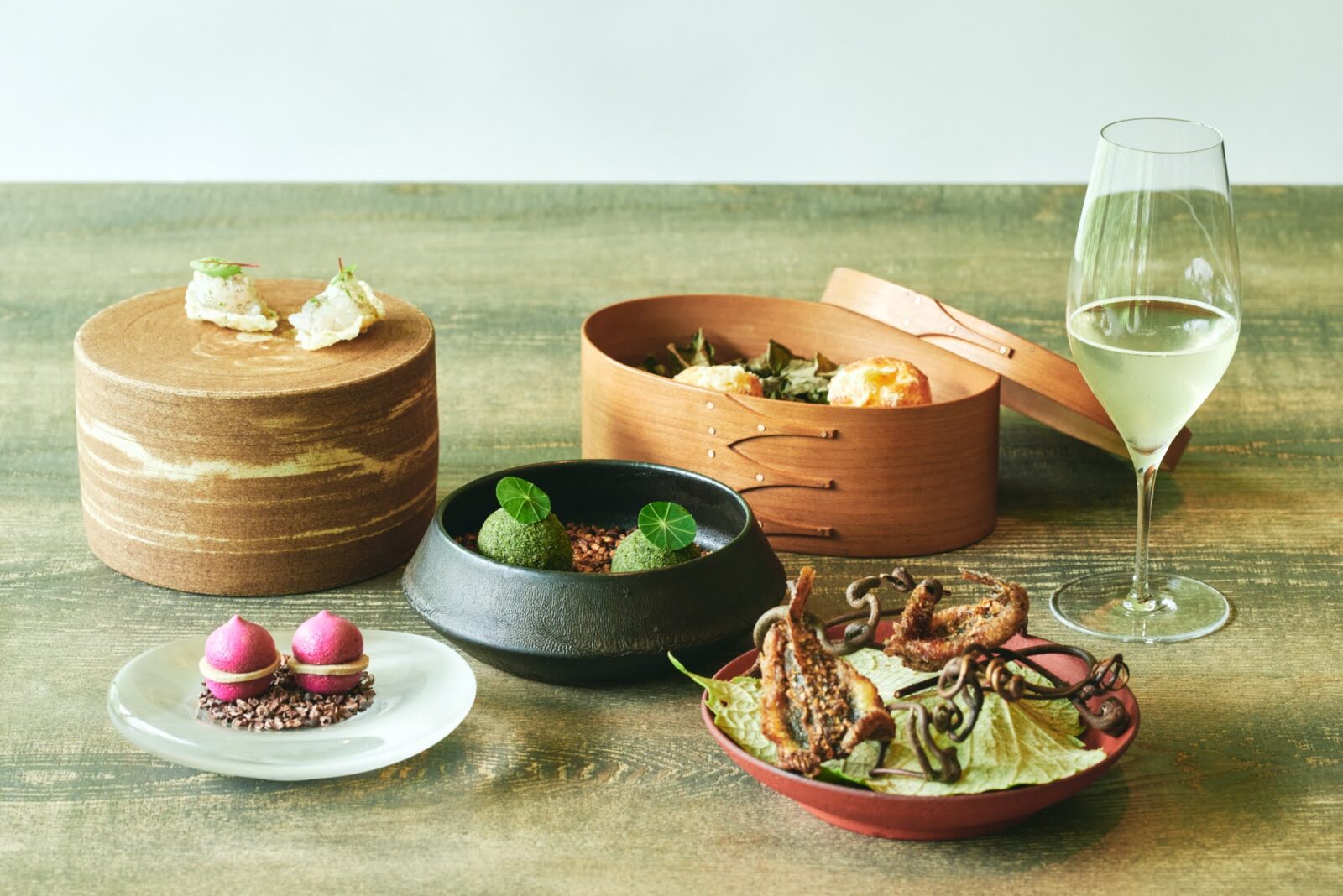
Prologue
The prologue of the course is a feast for the eyes with five dishes that look like they were prepared by forest fairies.
– Shiroebi (white prawns) flavored over a wood fire on a prawn rice cracker made with nori (seaweed) and sweet rice
– Gougères made with Kurobe Y&Co. goat cheese and Masuizumi sake lees
– Red beet meringue and L’évo’s chicken liver mousse
– Sea bream and potato croquette topped with nasturtium
– Ayukake (fourspine sculpin) from Oyabe River with sansho (Japanese pepper)
The drink pairing is an original cocktail made from Kuromoji, a common aromatic tree of Toga Village. Kuromoji extract is combined with honey, ginger and yuzu in a syrup and mixed with sparkling water made from the mountain spring water. It has a refreshing flavor with a hint of sourness and the fresh scent of Kuromoji spreads in your mouth.
Pike conger
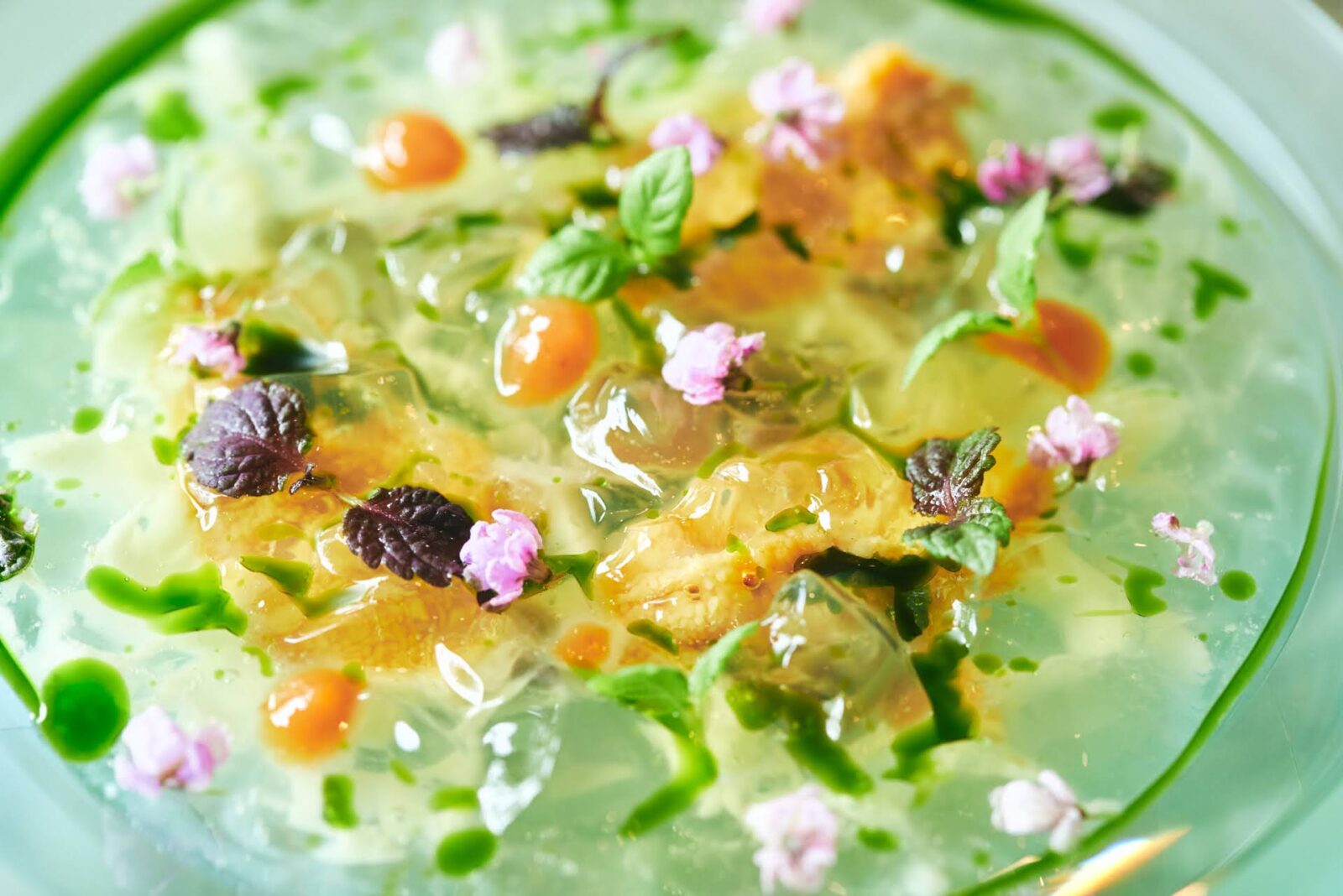
The pike conger dish does not include any meat of the fish, yet surprisingly tastes and feels like it does. The dish is made by turning a thick broth made from pike conger into a gel base and adding uni (sea urchin), junsai (watershield), shiso leaves, plum sauce, shiso oil, potato purée and molokhia. It is presented in a way that looks like a fresh waterbed in early summer, and it makes you want to savor it with your eyes for a moment. It is plated on an artistic plate by glass artist, Yukako Kojima.
Scabbard Fish

Next was a charcoal grilled scabbard fish on feuilletage (pie crust). It is garnished with zucchini, nasturtium buds and mache. In between the fish and the feuilletage is finely chopped Kaga cucumbers and truffles. The dish is placed on top of handmade Japanese paper from Gokayama and the dish has a full yet delicate flavor with a slight hint of Japanese flair.
Asian Black Bear

Bear meat that was hunted in the nearby mountains is cured for one month in a special aging room in the basement of the restaurant. Although it is commonly said that fatty bear meat tastes the best, chef Taniguchi chooses to serve lean meat. The dish is garnished with thistle, which bears are said to eat after coming out of hibernation, and is garnished with malabar spinach, yuzu, semi-dried tomato, and a malva flower topped with honey gelee. The rhythmic aromas and textures of the beautifully flavorful bear meat and the colorful vegetables are a delight to the palate.
The dish is paired with a tea made with a legume called Chamaecrista nomame. It is a traditional tea with a long history in the region and is made by roasting and boiling the plant leaves. It has an earthy aroma with a nutty flavor that lingers in your mouth and it goes perfectly with the game meat.
Ooettyubai (Sea Snail)
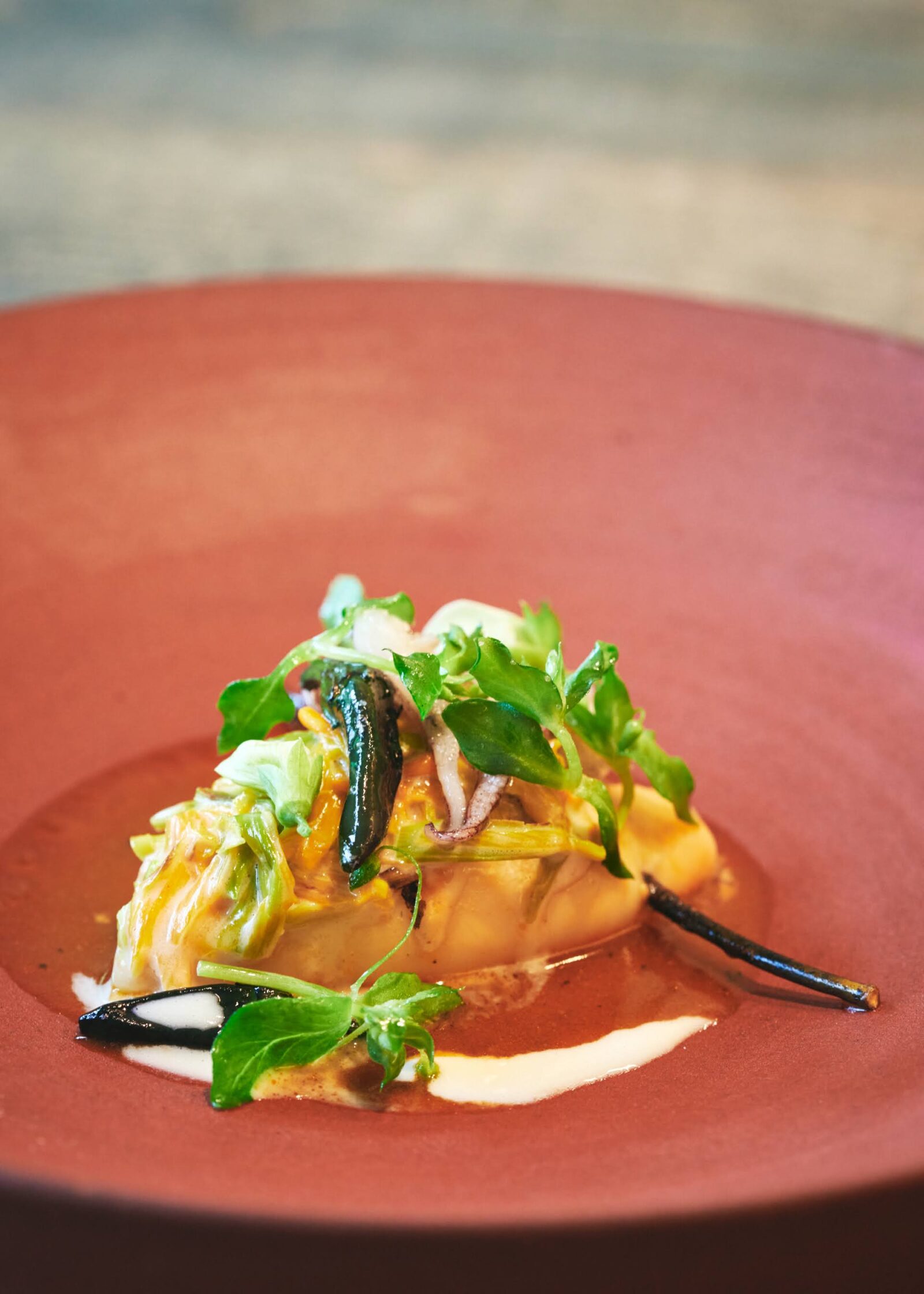
Ooettyubai is the largest sea snail that can be found in Toyama and it has a tender, sweet and strong flavor. The meat and liver sauce blends in the dish of colorful fennel, lettuce, dill flowers, matatabi leaves and sprouts, kuromoji seeds, and powdered olive seeds. To finish it off, green mustard oil is poured over the dish to create a dizzying harmony of spicy, sour, sweet flavors that is full of umami.
Red Squid
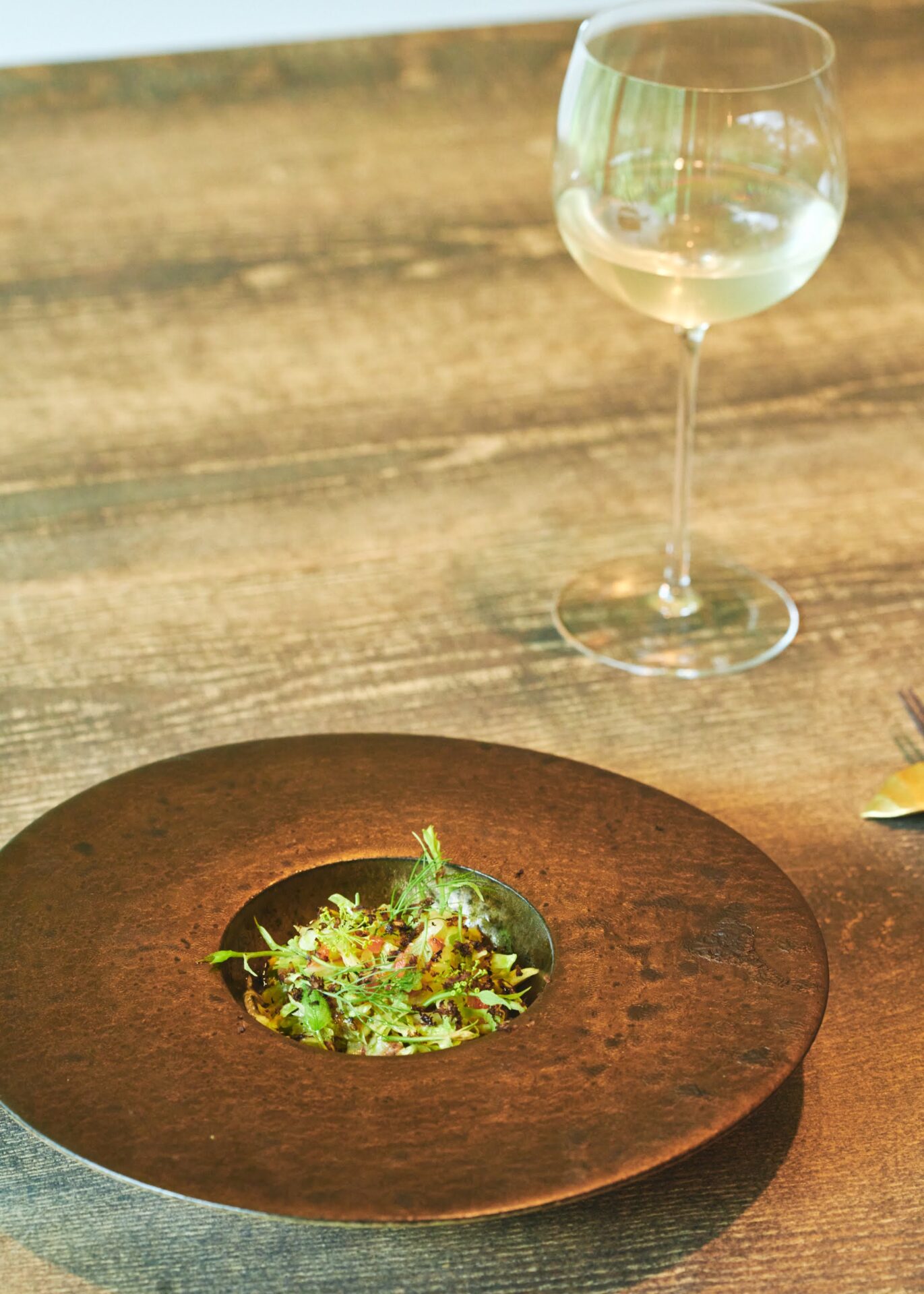
The red squid is stuffed with button shrimp and sealed with a kuromoji stick. It is garnished with hemerocallis fulva flowers, water spinach flowers, chickweed, shishito peppers, and fire-roasted red squid geso. It comes with two sauces: a red sauce with button shrimp jus and a white sauce made with hemerocallis fulva and vermouth wine. The herbs add a refreshing contrast to the sweet and mellow flavor of the squid and shrimp. The sauce is a flood of umami that makes you want to savor the aftertaste for as long as possible.
The drink pairing for the Ooettyubai and Red Squid is a blend of black beans, licorice, honey, cinnamon, goji berry and mugwort tea from Kamiichi Town that was produced by a professional tea blender. The refreshing tea has a medicinal complexity and a sweet mint-like freshness that blends well with the deep and creamy flavor of the dish.
Ookado Somen
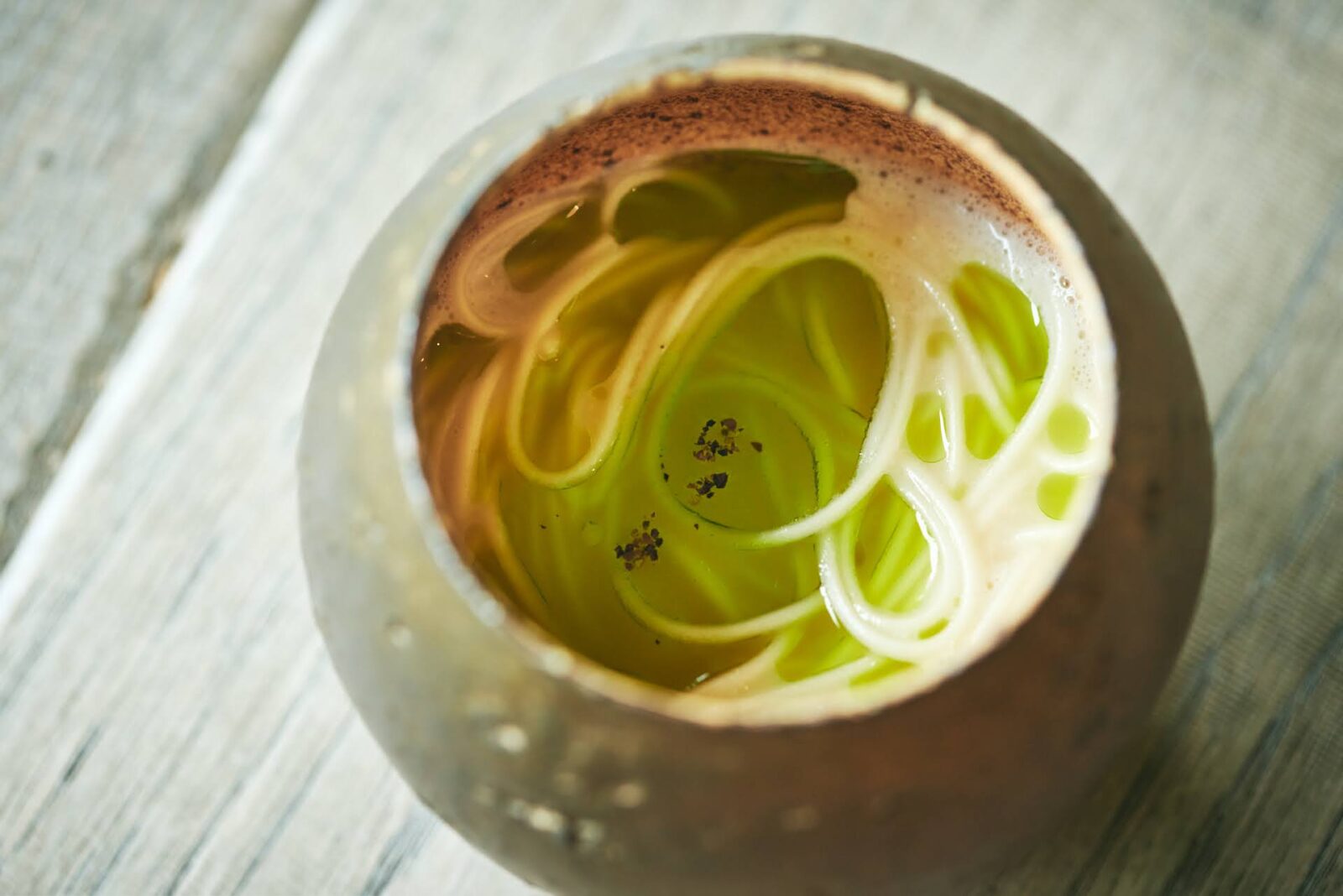
One of L’évo’s specialties is their noodle dish using Daimon Somen, a specialty of Toyama. The dried noodles that are available in markets are also delicious and have a nice firm texture, but L’évo has their noodles order-made. Their custom made noodles are delivered semi-raw and boiled to al dente.
The somen noodles are served with local and wild butterbur sprout oil and goal cheese from Kurobe Y&Co.The goat cheese mellows the bitterness of butterbur and when the sauce is combined with the chewy texture of the noodles, it creates an indescribable comforting and soothing experience.
The drink pairing is a bittersweet tea made with rosemary and wild mugwort picked in Nanto City. The slightly bitter tea blends with the butterbur flavor of the dish and awakens your taste buds.
L’évo Chicken
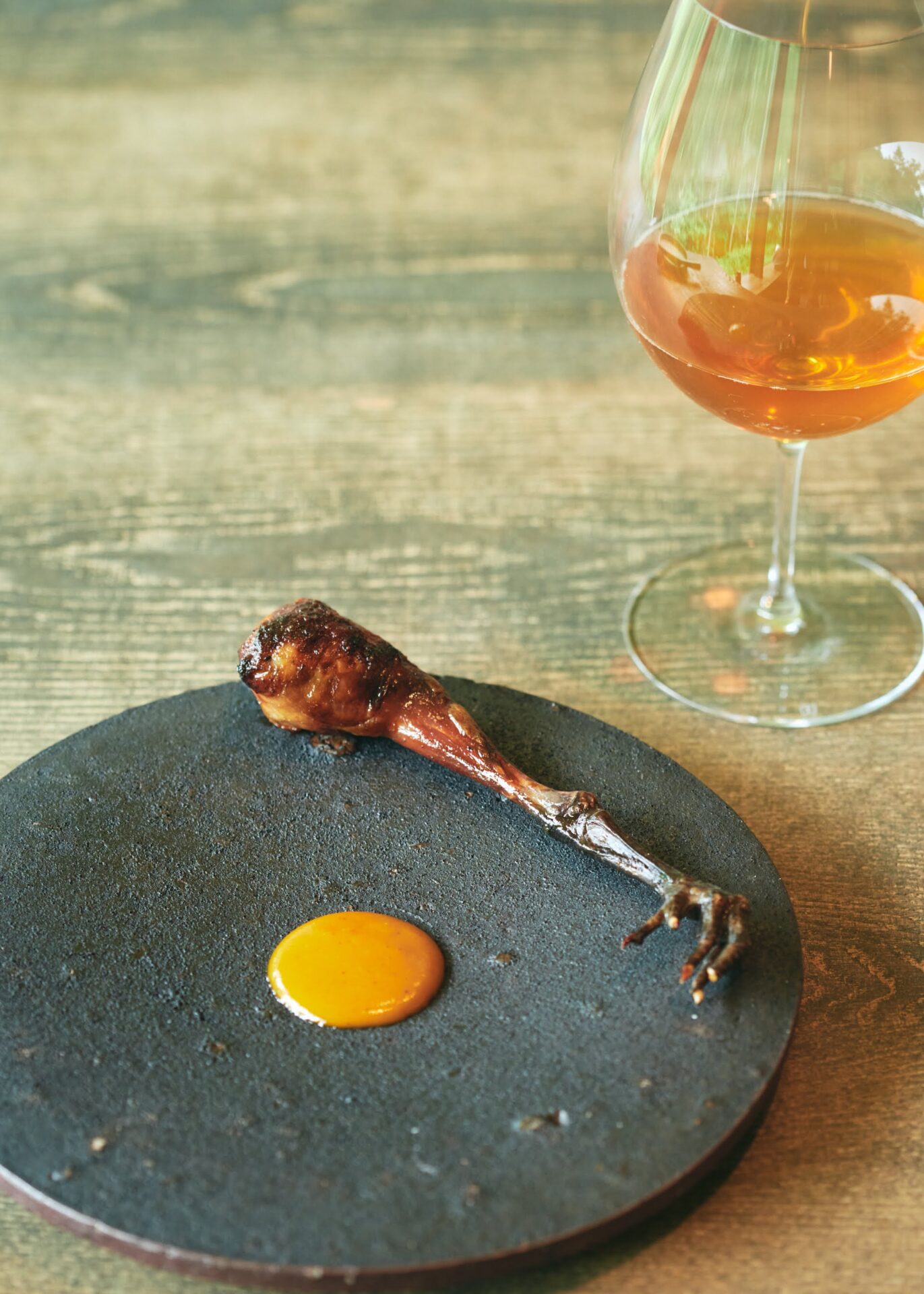
L’évo Chicken is the restaurant’s signature dish. The young chickens are raised exclusively for them at a farm in Toyama City, called Doyuuno. The chicken thigh is stuffed with rice cooked in chicken breast, thigh meat and bear intestines and is cooked over a wood fire. The yellow sauce in the middle of the plate is a Japanese mustard. It is served right off the fire and hot, so you carefully lift it with your fingers and bite into it whole.
A deep flavor excretes itself from the crispy chicken skin and the moist, tender meat and rice has such a delicious flavor that it silences you while you chew and savor it. The plate it is served on was made from soil that was dug up during the construction of the L’évo restaurant and is the creation of potter, Gaku Shakunaga.
Devil Stinger Fish
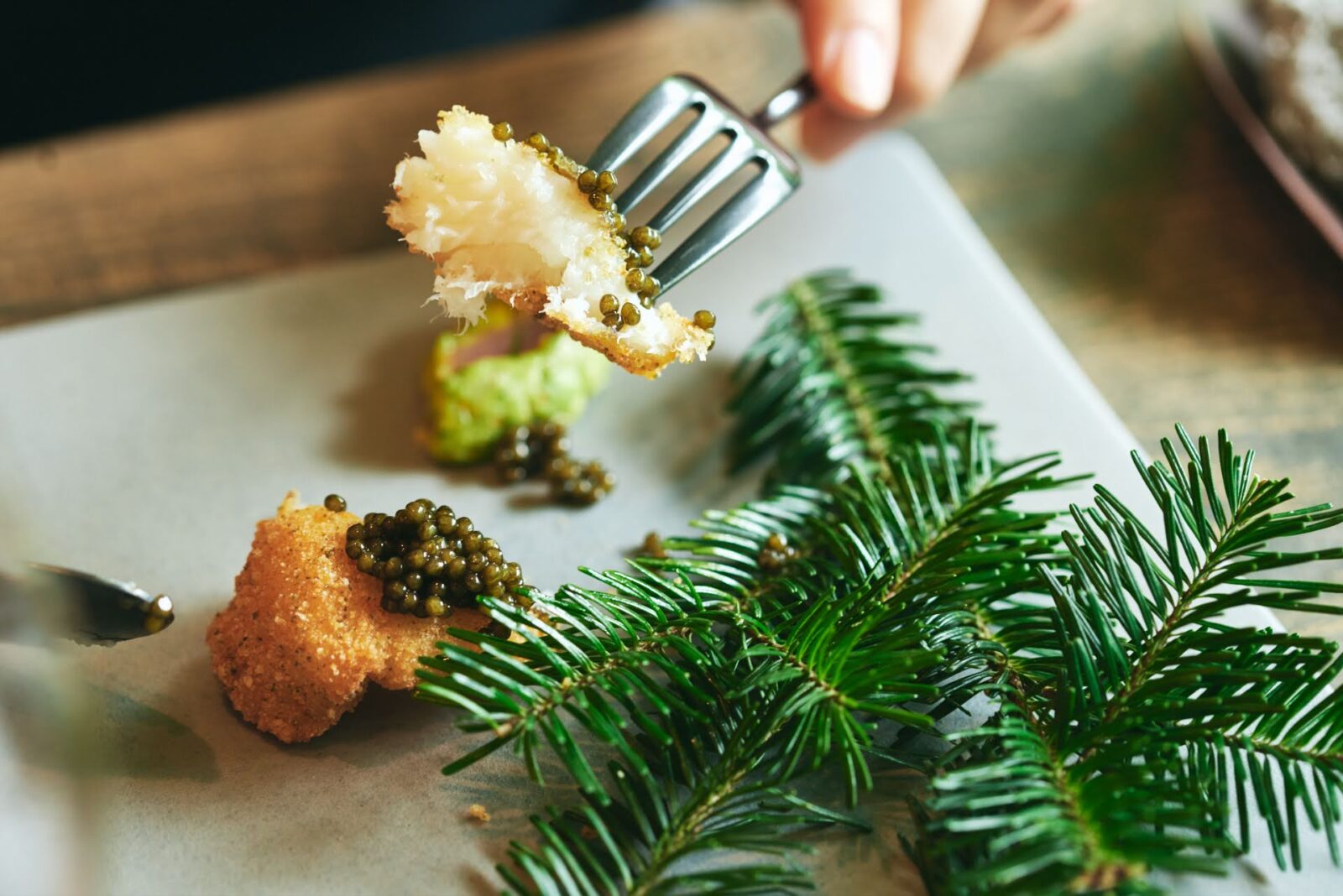
The devil stinger fish is covered in a batter of Toyama rice cooked in seaweed and shrimp broth. It is topped with caviar that compliments it very nicely and served with a paste made from fir leaves and avocado mixed with seafood extract. The subtle scent of the fir leaves enhances the rich avocado flavor while the seafood extract brings out yet another dimension of flavor.
The drink pairing for L’évo Chicken and the devil stinger fish is a glass of Kureha tea with ginger and lime. The Toyama clan began producing black tea in the Kureha region of Toyama (currently known as Western Toyama City). Although it has a long history and tea plantations still exist in the region today, they only produce in small quantities.
This Japanese black tea has a mild flavor with just the right amount of astringency and it accompanies the umami of the roasted ingredients of the dish while the lime and ginger provide a crisp accent.
Wild Boar
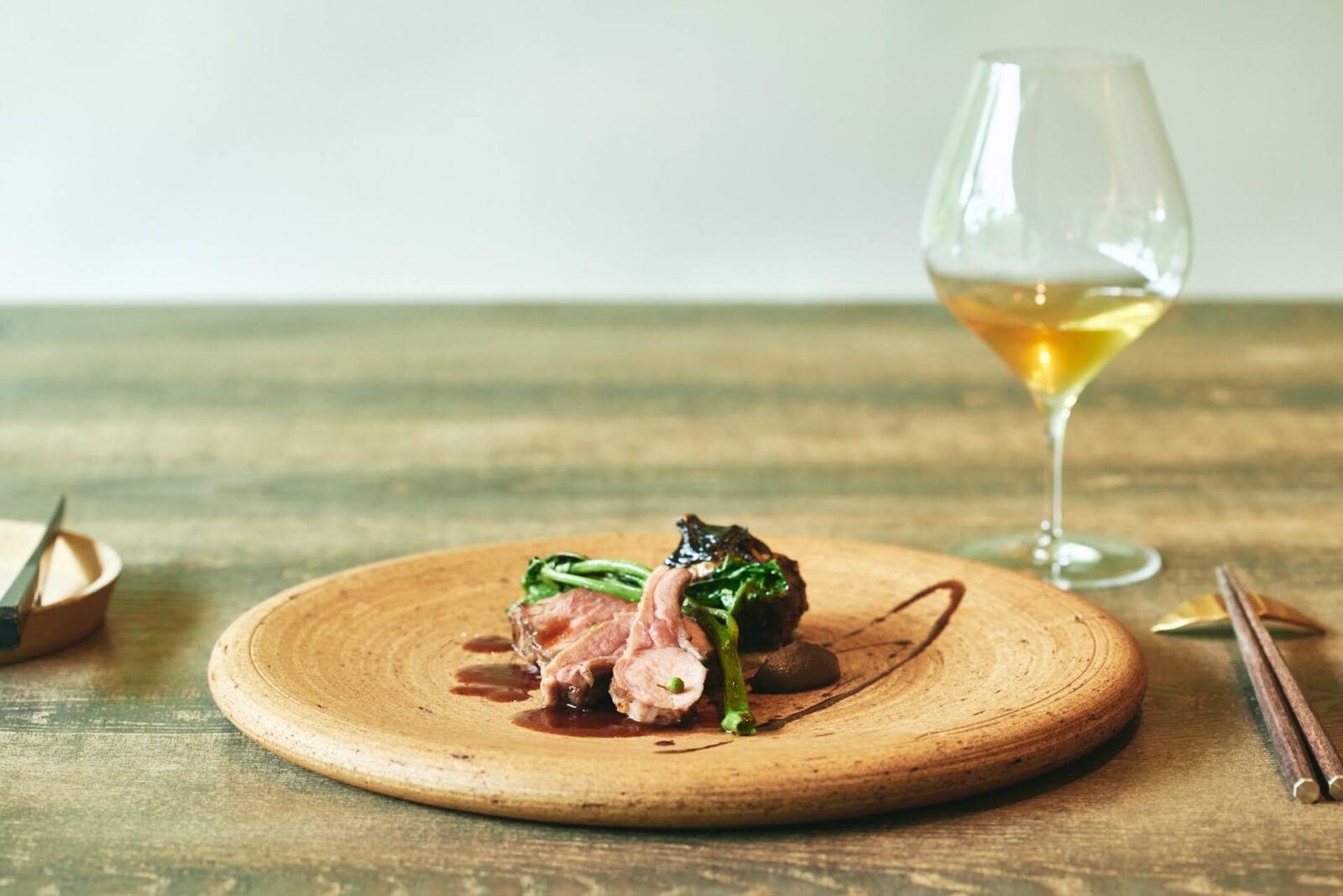
Uribo (wild baby boar) is slowly roasted over a wood fire and served with eggplant roasted whole over charcoal, Japanese pepper, water spinach, wild game sauce and eggplant peel sauce. The meat of the wild boar is moist, tender and smooth with a lingering umami. The spice of the Japanese pepper and the rich umami from the charcoal roasted eggplant further enhances the flavor.
The drink pairing is a kukicha (stem tea) that has been roasted on a stronger flame than the norm, accented with anise. The well-rounded roasty aroma goes well with the meat dish and the anise adds a spiciness that accentuates the flavor. Being the drink that is served before moving onto dessert, it also helps to refresh the palate.
Yuuka Melon

The dessert is fresh melon with melon sorbet topped with carbonated foam and shaved tonka beans. It is a grown up version of the familiar melon soda drink (melon flavored soda topped with ice cream) and it has a crisp and refreshing sweetness to it. On top of that, a bouquet of shishiudo flowers (wild celery) is presented to the table and the flowers are sprinkled on top of the dessert as a finishing touch. The dessert looks like something out of a fantasy picture book.
Kuromoji

There are an abundance of kuromoji trees that grow around Toga Village. The tree has a fresh, citrus-like aroma and the next dessert takes full advantage of this scent. The dessert is made entirely of kuromoji, except for the white flowers used as garnish. Each part of the pastry, from the dough to the cream sandwiched inside, the powder sprinkled on top and the caramel syrup is delicately infused with kuromoji. The elegant aroma of kuromoji lingers in your mouth and nose for a long and quiet moment.
The drink pairing for dessert was an original cocktail made with ginger ale and a handmade syrup of Shogawa winter yuzu citrus fruit. Shogawa is known as the northernmost area that grows yuzu in Japan. The drink is crisp and refreshing, like a clear mountain stream.

Finally, we were given a small box containing five sweets including an egoma financier, a chocolate puff with mulberry tea ice cream, a raspberry and milk raw caramel, an apple tart and a praline tart topped with Kaga Kukicha mousse. The course was finished with a kuromoji tea.
Every scent, texture and lingering flavor was an incredibly memorable experience. All five senses were stimulated in this magnificent course meal that allowed us to enjoy the wonders of Toyama and left us with a tremendous satisfaction.
Working with trusted comrades to refine and enhance each other’s skills
We experienced the non-alcoholic drink pairing for our course and the first thing that Taniguchi shared with us was that he is not involved in producing the drink pairings at all.
“The drink pairings are all prepared by a sommelier that I have worked with for more than ten years. I don’t interfere with drinks and I give my all to prepare the food. Since we use some of the same local ingredients I may occasionally share a cooking technique that can be applied to the drinks, such as how to extract aromas, etc. However, I don’t produce it or give them my opinions or thoughts.”
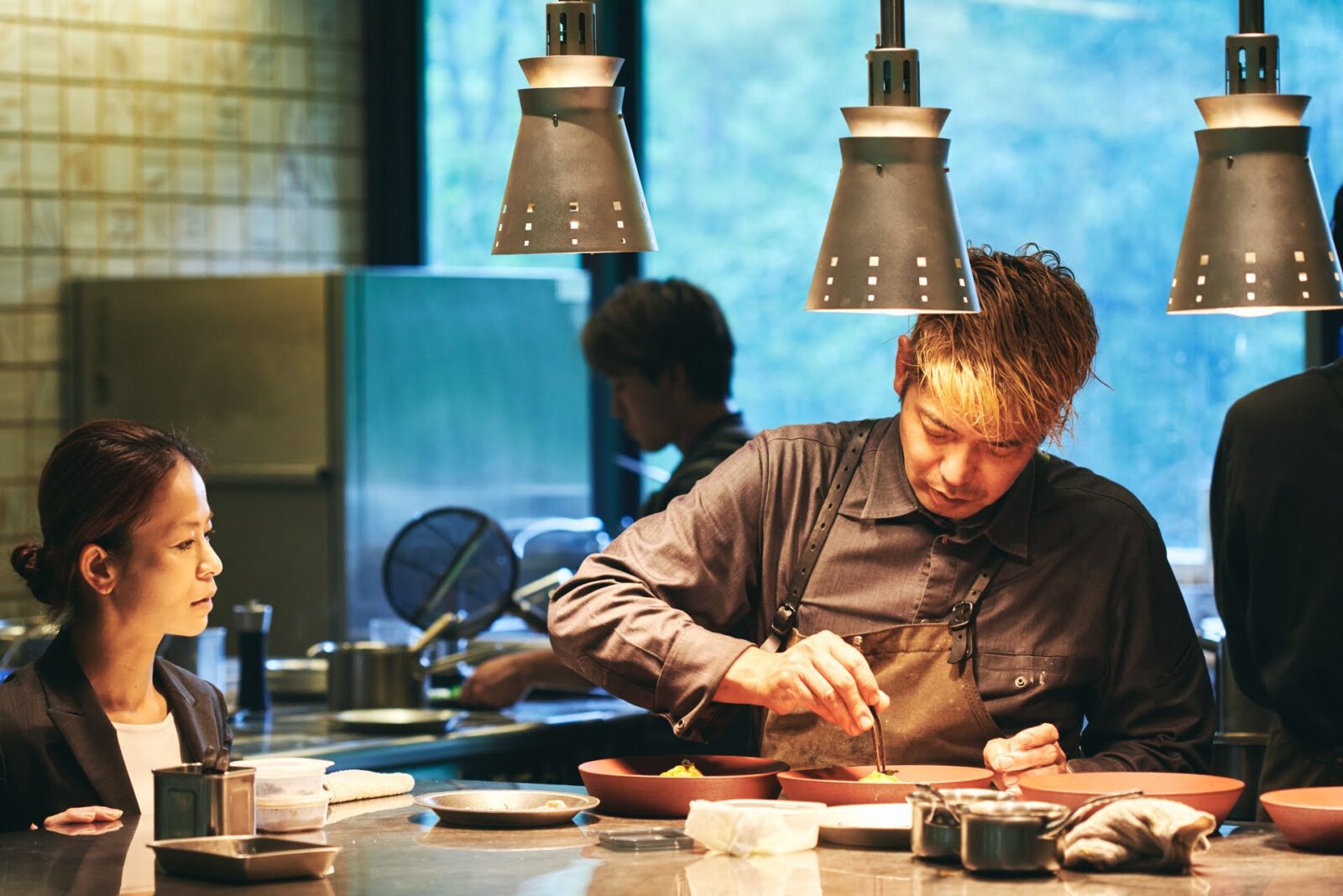
There are a wide range of specialists from Toyama that are working with L’évo, from the farmers who provide the produce, to the artists who create the tableware that compliments the food, to the interior designers who decorate the restaurant. On their official website, they introduce the many people involved as “Team L’évo”.
Taniguchi says that he doesn’t give instruction to any of these specialists.
“If I give them my input, it will no longer be their original work. I want them to feel and interpret my cooking with their own senses and come up with how they will compliment the dish to express themselves through their own work.”
Naturally, there are times when the result does not match with Taniguchi’s personal taste. However, he says that when he listens to the creators he often learns something new or gets inspired by them. He believes that this process and accumulation of such experiences helps each of them grow.
He meets with the creators and farmers frequently and they eat together and communicate often to deepen their relationship and trust.

“It may look like I am taking the lead from the outside, but in fact I am often being guided by my team and I feel like we are all ascending to new levels together.”
“This restaurant is made possible thanks to the support of the people around me. I am not originally from Toyama so I am always learning and being shown new things. I think that is why I enjoy my job so much.”
“L’évo’s philosophy will live on without me”

L’évo’s course begins with the sap of the Itaya maple named the “forest dewdrop”. It is a unique drink that allows one to directly and simply feel connected to the rich bounty of the local region. Drinking it makes you feel welcomed into Toga Village.
“Actually, this sap is being collected to study the growth and health of the trees. I was asked if there was some way to utilize it and that gave me the opportunity to work with it. Drinking sap water is not a common experience and I feel it gives our guests a direct experience of arriving in Toga Village. I think it is a valuable way to show our hospitality that is very unique to this region.”
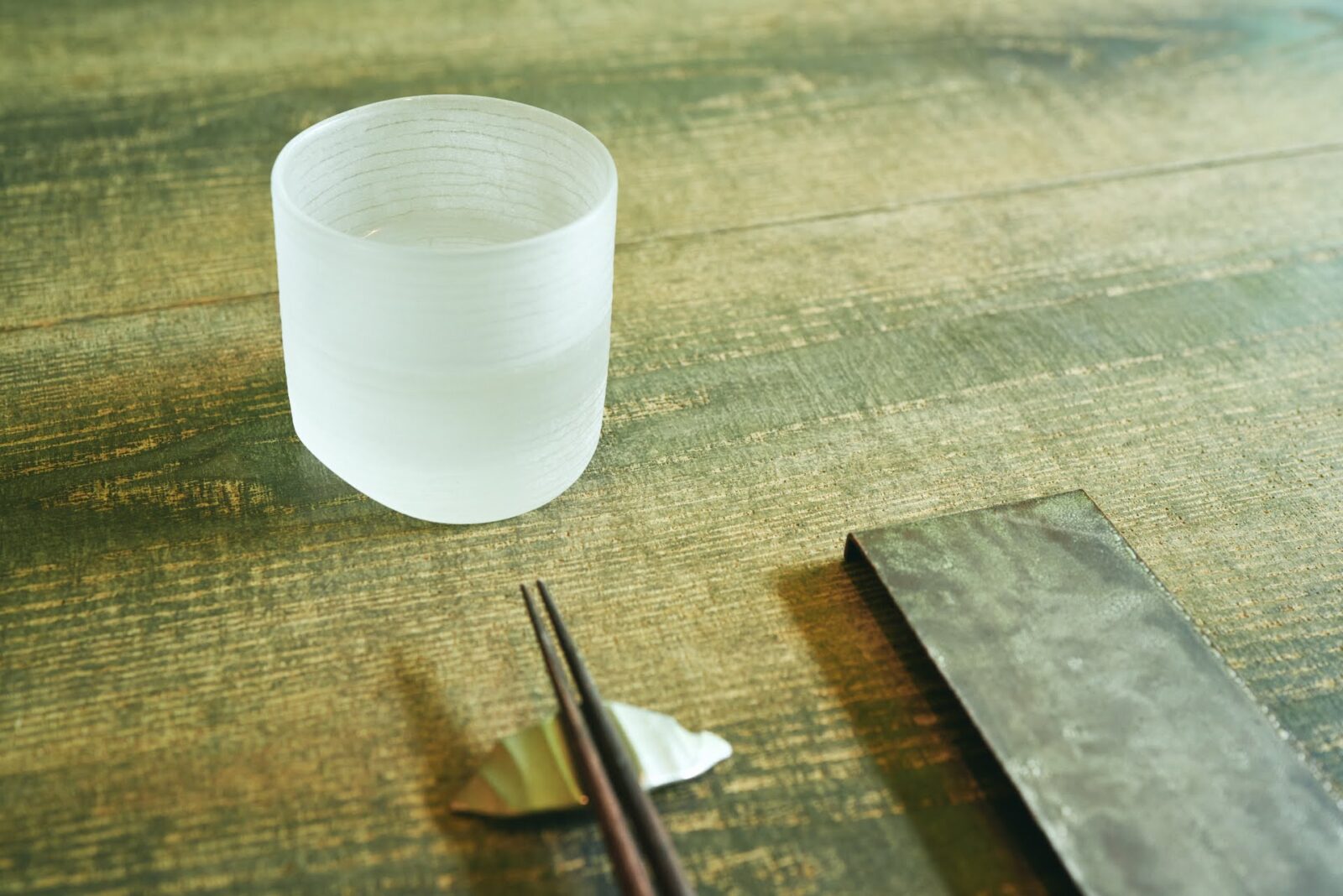
Mountain spring water is served throughout the dining experience. Unlike many restaurants, L’évo does not keep any imported mineral water on hand.
“No matter how famous the brand, I don’t feel right about serving water from a place I have never been to. Although it is a lot of work, I would rather walk into the mountains myself and fetch the water using my own feet and hands. I believe that top quality service comes from being able to provide proper explanation of what we are serving to our customers.”
“Although everything may not be top-notch right now, I believe that continuing to work on these individual details one at a time will improve our quality and encourage growth for everyone on our team. If we are better in five or ten years, that is good. We work hard everyday in anticipation of reaching that goal.”
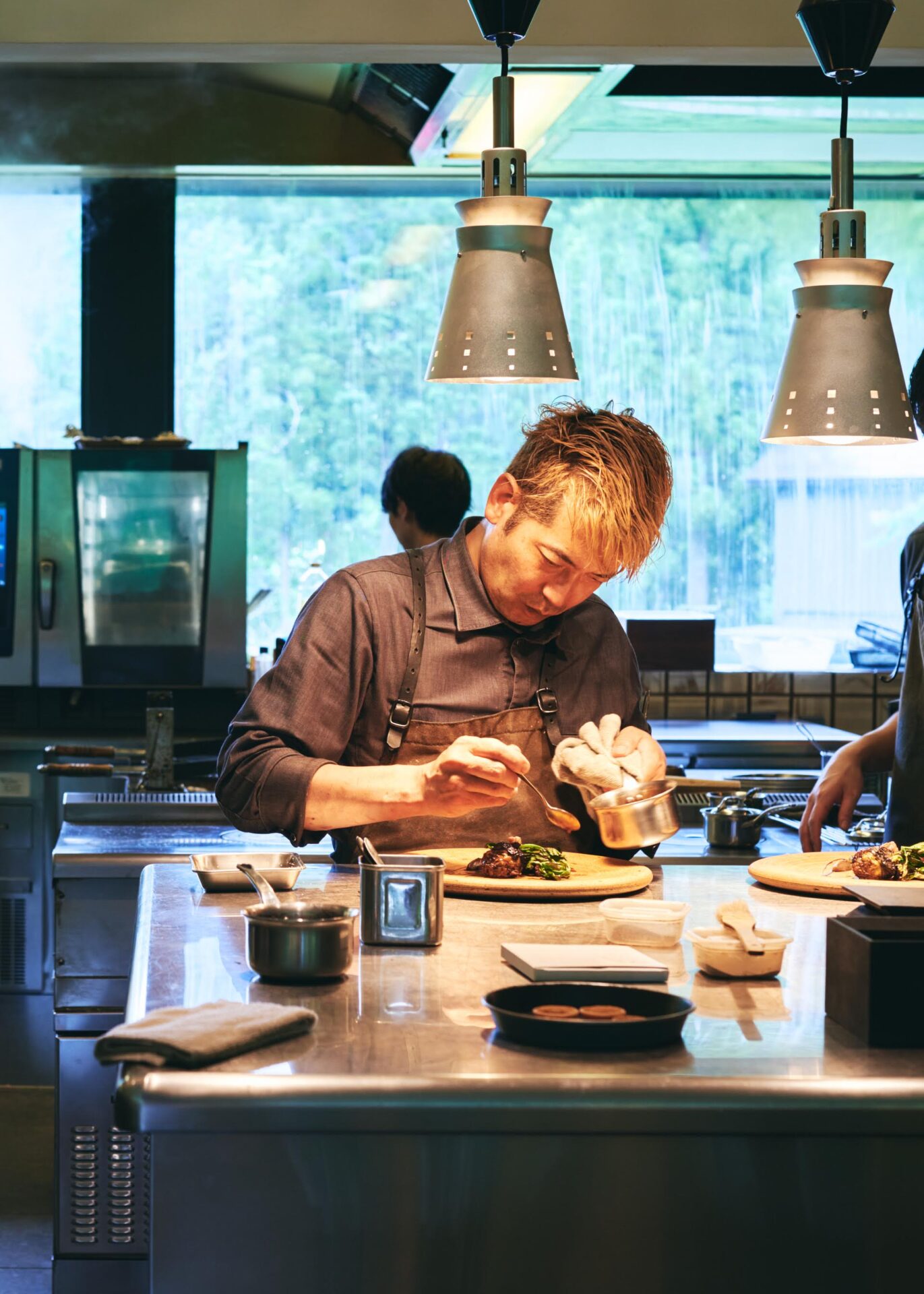
Taniguchi hopes that L’évo will remain in this land and become a restaurant that everyone can be proud of, even after he is gone. L’évo’s philosophy will continue. That is his ultimate goal.
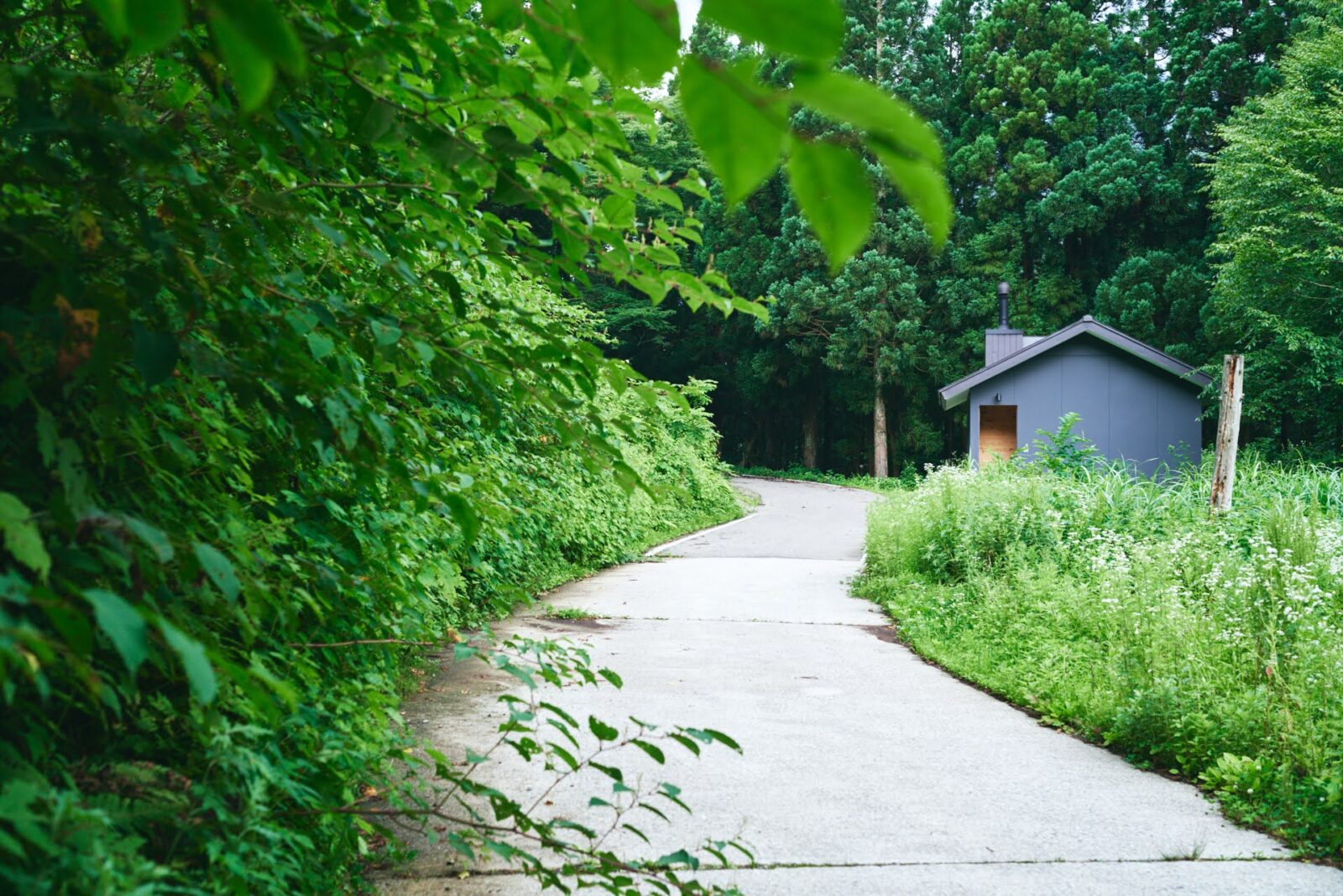
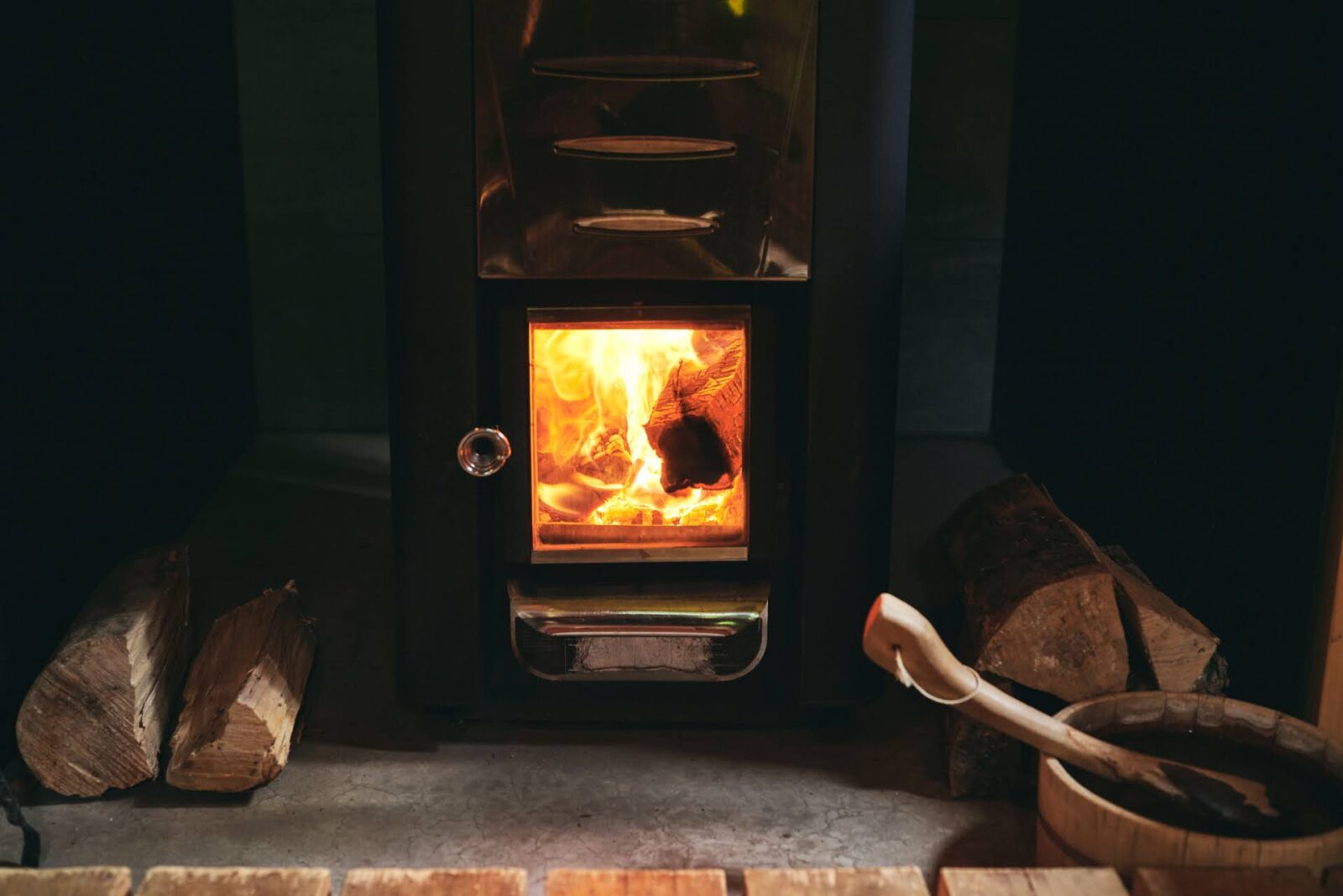
There are only merits to using the natural mountain spring water. Water makes all the difference.
L’évo is surrounded by mountains with altitudes of over 1,000 meters and it is abundant with nature. They are not connected to public water and have drawn their water from a natural spring about a 20 minute hike up the mountain by the restaurant. The water is purified using a custom-made purifier built inside the building and this water is used for all their facilities.
In other words, 100% of the cuisine prepared at L’évo uses mountain spring water. Usually, the use of spring water is subject to strict regulation and a license to use it for business is usually not permitted, but they underwent a vigorous application process and installed a large-scale purification system to make it happen. The financial investment for this was significant, but Taniguchi states that no matter the trouble, the benefits of using mountain spring water “only has merits”.
“Because it is natural spring water, the water sometimes gets muddy after heavy rains and it is unbelievably clear and cold during spring when the snow is melting. In the summer, it smells like the mountain because there are so many green leaves that fall into it.”
“It is a part of nature, so it changes everyday. I think that is how it should be.”
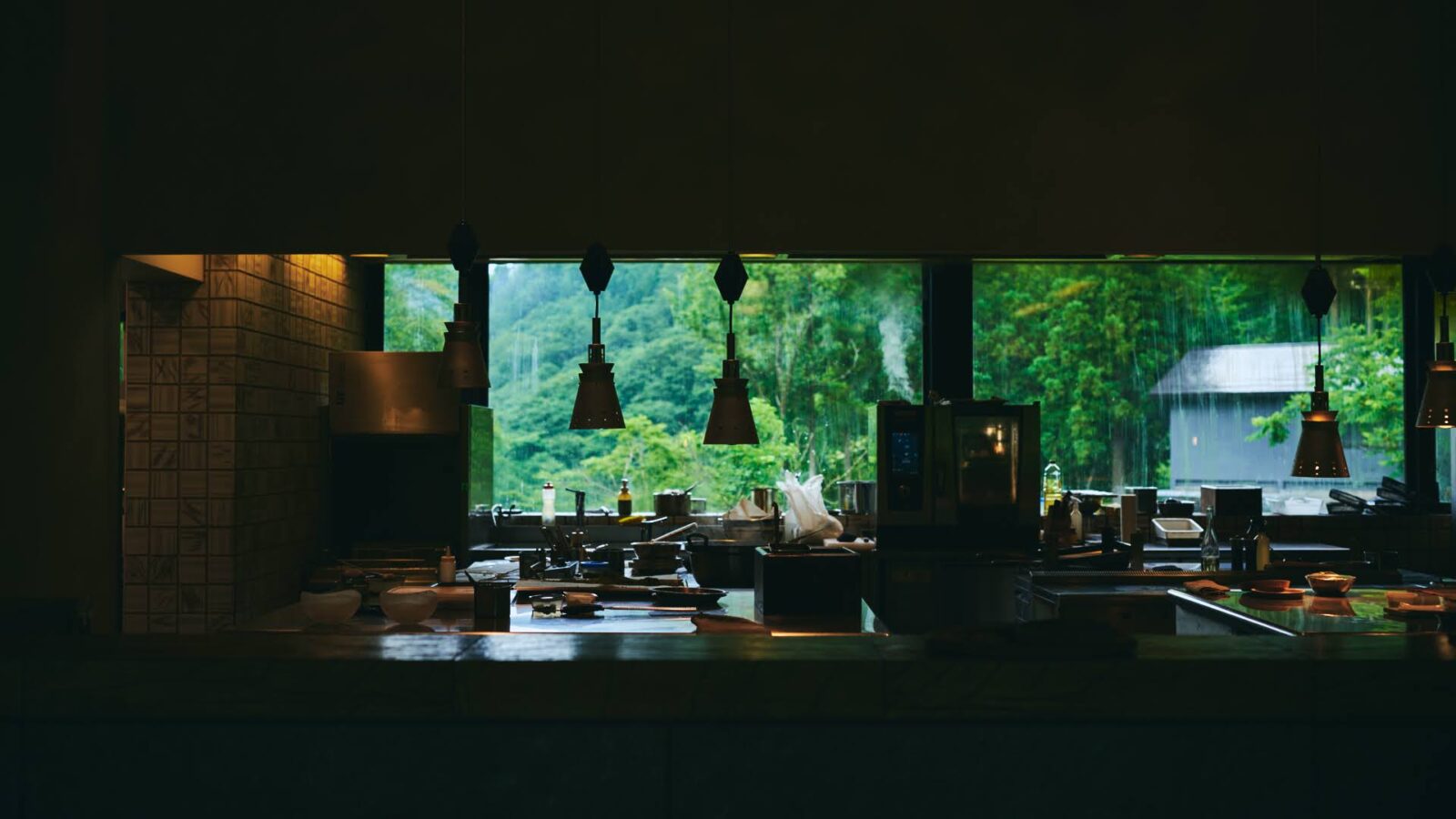
“Although our water changes with the season, I don’t really think about the season when it comes to the food. When I use local products that I am most interested in eating at the time,, naturally it changes with the season. The vegetables that are harvested at each season better suit the water at that time of year.”
“Plants and animals all need water to grow so the ingredients and how we experience them naturally match with the seasonal water. Cooking and good food is based on good water. Water makes all the difference.”
Taniguchi says, “Our biggest asset is the ingredients that we can only find in this region.” Of course there are some ingredients that are not locally available and there are inconveniences to their location.
Nonetheless, they work with what they have to bring out the best of the ingredients, follow what they learned from predecessors, study the local food culture and come up with new ideas all the time. This accumulation of experience and wisdom is reflected in the quality of their food.
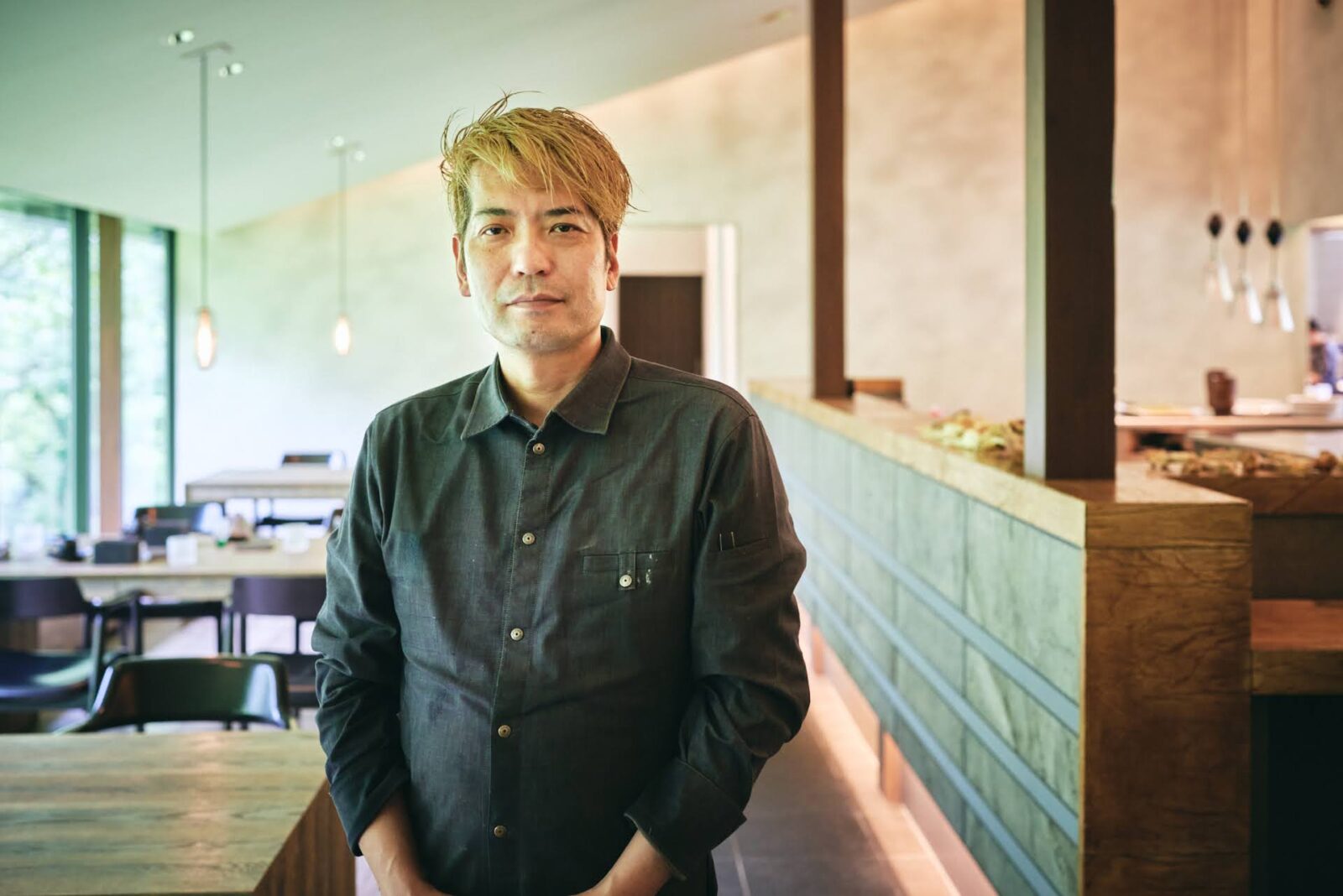
“Since my restaurant is here, I believe it is my duty as a chef to set my roots in this region and cook based on the land. Toyama is an incredible place and I have been blessed with both ingredients and people. It is a paradise for chefs, but there are still a lot of things I don’t know and plenty of room for further exploration.”
“In the past I used to think that mastering technique and skill was the most important thing for a chef. However, as I gain more experience and learn more about Toyama, now I believe that food becomes delicious simply on its own.”
It is clear that L’évo will continue to evolve as it looks to the future.
L’évo https://levo.toyama.jp/
Translation: Sophia Swanson
Advisor to corporations, and local governments on promoting local tourism. Published work includes, “Aomori & Hakodate Travel Book” (Daimond), “San’in Travel: Craft and Food Tour” (Mynavi), “A Drunkard’s Travel Guide: Sake, Snacks, and Tableware Tour” (Mynavi). Her life work is to explore towns in her travels, drink at different shops and visit the workshops of different crafts. Interests include tea, the Jomon period, architecture, and fermented foods.
Editor. Born and raised in Kagoshima, the birthplace of Japanese tea. Worked for Impress, Inc. and Huffington Post Japan and has been involved in the launch and management of media after becoming independent. Does editing, writing, and content planning/production.
